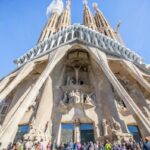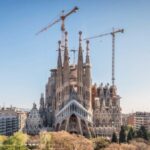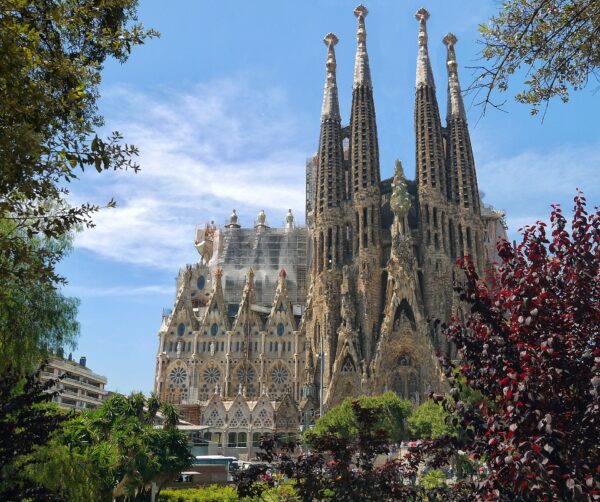
The Sagrada Familia, an architectural marvel designed by Antoni Gaudí, stands as a testament to the fusion of art and faith. Its intricate details and towering spires have captivated the hearts of millions, making it one of the most visited landmarks in the world.
As we explore The Completed Masterpiece: Sagrada Familia in Barcelona, we delve into Gaudí's visionary design and the passion that has driven the construction of this iconic basilica for over a century. The culmination of efforts and creativity results in a breathtaking symbol of devotion and ingenuity.
The Architectural Marvel of Sagrada Familia: A Masterpiece in Progress
The Sagrada Familia is not merely a church; it is an architectural marvel that embodies the innovative spirit of Antoni Gaudí. Each element, from the soaring towers to the meticulously crafted facades, reflects a deep connection between nature and spirituality. The ongoing construction is a testament to the enduring legacy of Gaudí's vision, drawing architects and tourists alike, eager to witness its grandeur.
One of the defining aspects of the Sagrada Familia is its unique structural techniques. Gaudí integrated several architectural styles, including Gothic and Art Nouveau, creating a harmonious blend that elevates the structure's aesthetic appeal. The use of hyperboloid structures and organic forms allows for natural light to flood the interior, enhancing the spiritual atmosphere:
- Hyperboloid structures - Provide stability and beauty.
- Organic forms - Mimic natural elements, fostering a sense of tranquility.
- Innovative materials - Enhance durability and visual impact.
As construction progresses, advancements in technology have allowed for greater precision and efficiency. The integration of 3D modeling and computer-aided design has revolutionized the way artisans approach the intricate details that make the Sagrada Familia a masterpiece in progress. This synergy between tradition and modernity ensures that Gaudí's original vision is preserved while meeting contemporary standards:
| Construction Phase | Year Started | Key Features |
|---|---|---|
| Nativity Facade | 1894 | Richly detailed sculptures, celebrating the birth of Jesus. |
| Passion Facade | 1954 | Emphasizes the suffering of Christ with stark simplicity. |
| Glory Facade | Planned | Intended to depict the glory of Christ and the final judgement. |
Ultimately, the Sagrada Familia represents more than just an architectural endeavor; it is a living symbol of faith and artistry. As each stone is laid, the basilica continues to inspire awe and admiration, affirming its status as an enduring masterpiece that bridges generations and cultures.
Exploring the Symbolism Behind Sagrada Familia's Unique Facade
The facades of the Sagrada Familia are a vivid representation of symbolism intertwined with religious and natural motifs. Each facade tells a distinct story, revealing intricate narratives that invite visitors to ponder their deeper meanings. The contrast between the three facades—the Nativity, Passion, and Glory—serves to illustrate the journey of faith through various stages of life: birth, suffering, and resurrection.
In exploring the Nativity Facade, one can see elements that celebrate creation and joy. The abundance of sculptures depicting flora and fauna signifies Gaudí's reverence for nature, emphasizing the connection between the divine and the earthly. This facade reflects the birth of Christ not just as a religious event, but also as a celebration of life itself. Key symbolic features include:
- Floral motifs - Representing new beginnings and divine beauty.
- Angelic figures - Symbolizing spiritual guidance and protection.
- Animals - Illustrating harmony within creation.
Conversely, the Passion Facade presents a stark and dramatic interpretation of Christ's suffering. The angular shapes and rough textures convey a sense of turmoil and sacrifice, inviting contemplation on the human condition. The choice of materials and forms emphasizes the gravity of the events depicted, with each element crafted to evoke strong emotional responses. Key aspects include:
- Jagged lines - Reflecting the pain and struggle of Christ.
- Muted colors - Enhancing the sense of somber reflection.
- Minimalist sculptures - Bringing focus to the narrative of suffering.
Finally, the forthcoming Glory Facade is anticipated to encapsulate the triumph of faith and the divine glory of Christ. It aims to represent the culmination of the spiritual journey, merging earthly and heavenly realms. The design promises to reflect themes of resurrection and promise, ultimately serving as a beacon of hope for all who visit the Sagrada Familia.
Gaudí’s Vision: The Artistic Genius of Sagrada Familia
Antoni Gaudí's vision for the Sagrada Familia was deeply rooted in his understanding of nature and spirituality. He believed that architecture should seamlessly integrate with the environment, embodying the essence of the natural world. This philosophy is evident in the basilica's organic shapes and vibrant colors, which create a sense of harmony and tranquility throughout the structure.
Gaudí's innovative approach can be summarized through several key elements that define the artistic genius of the Sagrada Familia:
- Nature-inspired designs - Elements like tree-like columns evoke a forest atmosphere.
- Symbolic geometry - Shapes and forms represent spiritual concepts, connecting earthly realities with divine truths.
- Use of light - Strategic placement of stained glass enhances the interior, transforming light into a spiritual experience.
Additionally, Gaudí’s commitment to craftsmanship is unparalleled, as he worked closely with artisans to ensure that every detail reflected his vision. This collaborative spirit not only preserved traditional techniques but also fostered innovation, allowing the Sagrada Familia to evolve continuously while remaining true to its original inspiration:
| Artistic Element | Description | Significance |
|---|---|---|
| Column Design | Tree-like structures that rise and branch out. | Symbolizes life and growth, enhancing the connection to nature. |
| Stained Glass | Intricately designed to filter light in various colors. | Creates an ethereal ambiance, reflecting spiritual themes. |
| Sculptural Details | Meticulous carvings and figures throughout the building. | Tells biblical stories and conveys deeper meanings of faith. |
In essence, Gaudí's artistic genius is not just in the physical structure of the Sagrada Familia, but in the profound messages it conveys. Each aspect of the basilica serves as a narrative of faith, inviting visitors to connect with both the divine and the natural world, making it a true masterpiece of spiritual architecture.
The Spiritual Significance of Sagrada Familia in Modern Barcelona
The Sagrada Familia holds profound spiritual significance for many in modern Barcelona, blending architectural beauty with deep-rooted faith. As a cathedral still under construction, it symbolizes the ongoing journey of spiritual growth and the aspirations of a community united in faith. This living monument invites individuals to reflect on their spiritual paths, offering a space for contemplation amidst its towering spires and intricate sculptures.
Visitors often describe the Sagrada Familia as a place where the sacred and the artistic converge. The interplay of natural light through stained glass creates a mesmerizing effect, transforming the interior into a kaleidoscope of colors that evoke a sense of divine presence. The atmosphere encourages reflection and prayer, making it more than just a tourist attraction but a genuine sanctuary for the soul.
Moreover, the basilica serves as a reminder of the cultural heritage of Barcelona, rooted in its religious history. The Sagrada Familia reflects the city's devotion to artistic expression and the fusion of creativity with spirituality. This unique combination attracts artists, theologians, and tourists alike, all drawn to the basilica's ability to articulate the complex relationship between faith and modernity.
In essence, the Sagrada Familia stands as a beacon of hope and inspiration. It embodies the collective dreams of those who have dedicated their lives to its construction, reminding us of the importance of faith and community. As the basilica continues to rise, it remains a powerful symbol of perseverance and spiritual significance in the heart of Barcelona.
Visitor's Guide: How to Experience the Sagrada Familia in 2023
To fully experience the Sagrada Familia in 2023, visitors should consider purchasing their tickets online in advance. This approach not only helps avoid long queues but also ensures entry during preferred times. Given the basilica's immense popularity, booking ahead of time is recommended, especially during peak tourist seasons. Various ticket options are available, including guided tours that provide deeper insights into Gaudí's architectural genius.
Once inside, take the time to explore the stunning interior, where the interplay of light and color creates a serene atmosphere. The intricate stained glass windows are a highlight, casting vibrant hues throughout the nave. For a more immersive experience, consider using an audio guide or joining a small group tour. This will enhance your understanding of the symbolism embedded in the design and the ongoing construction of this iconic masterpiece.
To appreciate the Sagrada Familia from different perspectives, remember to visit the surrounding park areas. Places like the Plaça de Gaudí offer breathtaking views of the basilica, perfect for photography or quiet contemplation. Additionally, attending a mass or special event can provide a unique glimpse into the spiritual significance of the site, connecting visitors with the local faith community.
Finally, be sure to check the official website for any updates regarding construction progress or special exhibitions scheduled for 2023. Engaging with the ongoing story of the Sagrada Familia enriches the visit, allowing you to witness the evolution of this remarkable project that embodies both artistry and devotion.
Sagrada Familia: A Testament to Art and Faith in Barcelona
The Sagrada Familia is not just an architectural feat; it stands as a profound emblem of faith and artistic expression in Barcelona. Designed by the visionary Antoni Gaudí, this basilica intertwines elements of spirituality and creativity, drawing countless visitors who seek not only its aesthetic beauty but also its deeper meanings. This remarkable structure invites people to reflect on their own beliefs while appreciating the craftsmanship that has gone into its creation over more than a century.
At the heart of the Sagrada Familia's allure is its ability to evoke a sense of wonder through its unique design elements. The basilica features:
- Nature-inspired motifs - Integrating forms that resemble plants, animals, and natural landscapes.
- Innovative spatial solutions - Creating a luminous interior that enhances the spiritual experience.
- Symbolic sculptures - Illustrating biblical stories and messages of faith that resonate with visitors.
Moreover, the ongoing construction of the Sagrada Familia signifies a dynamic journey of artistic and spiritual growth. Each phase of the project adds layers of meaning, allowing new generations to connect with Gaudí's vision. The use of contemporary technologies, such as 3D printing and precision tools, ensures that each detail remains true to the original designs while adapting to modern techniques. This blend of tradition and innovation reinforces the basilica's status as a living testament to the enduring power of faith and art.
Ultimately, the Sagrada Familia serves as a sanctuary where the sacred and the artistic converge. Its grandeur inspires awe and contemplation, providing a space for visitors to connect with their spirituality in a unique environment. As this masterpiece continues to rise, it remains a defining symbol of Barcelona, embodying the city's rich cultural heritage and its unyielding faith.
 The Majestic Towers of Sagrada Familia: A Must-See in Barcelona
The Majestic Towers of Sagrada Familia: A Must-See in Barcelona The Saga of Sagrada Familia: Barcelona's Timeless Construction
The Saga of Sagrada Familia: Barcelona's Timeless ConstructionIf you want to know other articles similar to The Completed Masterpiece: Sagrada Familia in Barcelona you can visit the category WHERE YOU CAN GO.
Leave a Reply










Read more!